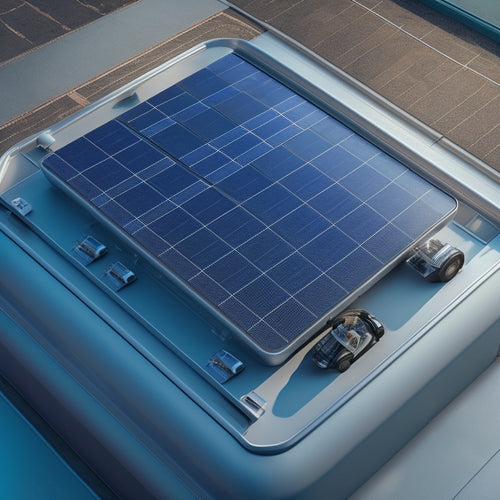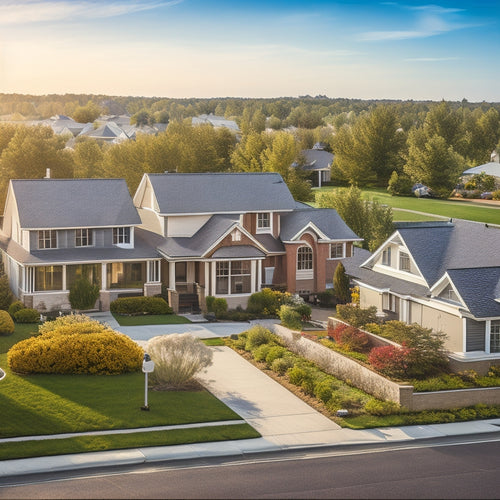
What Are the Top Things to Know About Solar Power Installation Costs
Share
As you investigate solar power installation costs, you'll find that upfront expenses are just the beginning. System size, installation complexity, and regional variations all impact costs, with factors like labor quality, material selection, and installer reputation playing a significant role. Additionally, roof size and orientation, financial incentives, and battery storage system costs will influence your overall investment. Permitting and inspection fees, as well as maintenance and repair expenses, should also be considered. By understanding these key factors, you'll be better equipped to steer through the solar power installation process and make informed decisions about your investment, and there's more to uncover about how to maximize your solar power installation's value.
Key Takeaways
- System size, installation complexity, and cost per watt significantly impact upfront solar power installation costs, with larger systems yielding greater energy output.
- Regional variations in solar costs exist due to local factors such as labor costs, incentives, and supplier proximity, affecting the final cost per watt.
- Installation quality, influenced by labor quality, material selection, and installer reputation, critically affects overall solar power costs and long-term performance.
- Financial incentives, including federal and state rebates, tax credits, and utility programs, can significantly offset solar power installation costs and increase adoption.
- Additional costs, such as battery storage systems, permitting and inspection fees, and maintenance and repair expenses, should be factored into the overall cost of solar power installation.
Understanding Solar Panel Costs
Typically, homeowners and businesses contemplating solar power installation are concerned about the upfront costs. However, it's vital to take into account the long-term solar savings and energy efficiency that come with going solar.
You'll not only reduce your carbon footprint, making a positive environmental impact, but also increase your energy independence.
Financing options are available to help offset the initial investment, and system warranties provide peace of mind. With rapid technology advancements, the cost of solar panels has decreased greatly, making it a more viable option.
Additionally, grid connectivity allows you to sell excess energy back to the grid, further increasing your return on investment.
When planning your solar power installation, it's important to reflect on the installation timelines, ensuring a smooth changeover to renewable energy.
System Size and Installation Costs
You'll find that the cost of a solar power installation is heavily influenced by the system's size, which in turn affects the number of panels required.
As you consider different system sizes, keep in mind that more panels mean higher costs, but also greater energy output.
The complexity of the installation itself, such as the need for additional hardware or labor-intensive mounting systems, will also impact the final cost of your solar power installation.
System Size Affects Cost
When considering a solar power installation, one vital factor to keep in mind is that the system size has a direct impact on the overall cost. The larger the system, the more expensive it will be. However, a larger system also means more energy efficiency and a greater reduction in your reliance on traditional energy sources.
Here are some key considerations when it comes to system size and cost:
-
A larger system requires more panels, which increases the upfront cost but also provides more electricity and a faster return on investment.
-
A bigger system often requires more complex installation, which can drive up labor costs.
-
You may need to upgrade your electrical infrastructure to accommodate a larger system, adding to the overall expense.
- Financing options may vary depending on the system size, with larger systems potentially requiring more significant loans or investments.
Ultimately, it's important to assess your energy needs and budget to determine the best system size for your situation. By doing so, you can maximize your energy efficiency while minimizing your upfront costs.
Panel Quantity Matters
As the number of solar panels increases, so does the upfront cost of the installation, but it also leads to a greater energy output and faster return on investment. This is because more panels translate to a higher production capacity, allowing you to generate more electricity and reduce your reliance on the grid. However, it's crucial to evaluate the panel efficiency when determining the ideal system size for your needs.
| System Size | Number of Panels | Daily Energy Production |
|---|---|---|
| Small | 10-15 | 20-30 kWh |
| Medium | 20-30 | 40-60 kWh |
| Large | 40-50 | 80-100 kWh |
When deciding on the number of panels, you'll need to balance the upfront cost with the potential savings. A larger system may provide more energy, but it also increases the installation cost. On the other hand, a smaller system may be more affordable but may not meet your energy needs. Evaluating your energy requirements and understanding panel efficiency will help you determine the best system size for your solar power installation.
Installation Complexity Impacts
Installation complexity greatly affects the overall cost of a solar power installation, with system size being a primary factor. As you consider installing solar power, you'll want to understand how installation complexity impacts your costs.
A larger system size often requires more complex installations, leading to higher labor costs and longer project timelines.
Some installation challenges that can drive up costs include:
-
Site assessment and equipment accessibility: If your roof is difficult to access or has multiple skylights, chimneys, or vents, installation may require additional labor and equipment.
-
Structural modifications: If your roof needs reinforcement or repairs before installation, this can add to the overall cost.
-
Weather considerations: Inclement weather, such as high winds or extreme temperatures, can slow down installation and increase labor costs.
- Code compliance: Ensuring your installation meets local building codes and regulations can add complexity and costs to your project.
Understanding these factors will help you better estimate your installation costs and plan your solar power project effectively.
Cost Per Watt of Solar Energy
When you're evaluating solar power installation costs, it's vital to take into account the cost per watt of solar energy, as it fluctuates considerably depending on the system size you're installing.
You'll find that regional variations also apply, with different locations having different costs per watt.
Additionally, the quality of the installation itself impacts the cost per watt, making it imperative to balance upfront costs with long-term performance.
System Size Matters
Your solar power system's size greatly impacts its overall cost, with the cost per watt of solar energy being a key metric in determining the final bill. A larger system typically results in a lower cost per watt, as the fixed costs of installation are spread across more watts of energy production.
Here are some key factors to evaluate when assessing the cost per watt of your solar power system:
-
System efficiency: A more efficient system will produce more energy per watt, reducing the overall cost per watt.
-
Energy savings: A larger system will typically result in greater energy savings, which can help offset the upfront cost of installation.
-
Installation complexity: More complex installations, such as those with multiple roof angles or obstructions, may increase the cost per watt.
- Equipment quality: High-quality equipment with a longer warranty period may increase the upfront cost, but can provide better long-term value.
Regional Variations Apply
The cost per watt of solar energy varies considerably across different regions, primarily due to differences in labor costs, local incentives, and regulatory requirements. As you investigate solar power installation costs, it is important to understand how regional pricing affects your investment. Geographic factors, such as proximity to suppliers and transportation costs, also influence the final cost.
Here's a breakdown of regional variations in solar energy costs per watt:
| Region | Cost per Watt | Factors Influencing Cost |
|---|---|---|
| California | $2.73 | High labor costs, strong local incentives |
| Texas | $2.35 | Lower labor costs, abundant sunlight |
| Northeast | $3.15 | Higher labor costs, complex regulatory requirements |
You'll notice that California's high labor costs and strong local incentives drive up the cost per watt, while Texas's lower labor costs and abundant sunlight make it a more affordable option. The Northeast region faces higher labor costs and complex regulatory requirements, resulting in a higher cost per watt. Understanding these regional variations is vital in determining the true cost of your solar power installation.
Installation Quality Impacts
Solar power installation costs are also heavily influenced by the quality of the installation itself. You need to evaluate the installation standards, labor quality, material selection, and warranty protection when assessing the cost per watt of solar energy.
The quality of the installation can greatly affect the performance and longevity of your solar power system. Here are some key factors to evaluate:
-
Labor quality: The experience and skill of the installation team can affect the overall quality of the installation. Look for installers with a proven track record and certifications from reputable organizations.
-
Material selection: The type and quality of materials used can impact the system's performance and durability. High-quality materials may cost more upfront but can provide better long-term value.
-
Installer reputation: Research the installer's reputation online and ask for references to verify they've a history of providing high-quality installations.
- Project management: Effective project management is critical to confirm the installation is completed on time, within budget, and to your satisfaction.
Roof Size and Orientation Impact
Roof dimensions and layout play an essential role in determining the suitability of a solar power installation. As you consider going solar, you'll want to assess your roof's size, shape, and orientation to guarantee maximum energy efficiency. A larger roof with minimal shading effects can accommodate more panels, increasing your energy output. Conversely, a smaller roof or one with significant shading may require more efficient panels or creative installation designs.
| Roof Characteristic | Impact on Solar Installation | Considerations |
|---|---|---|
| Roof Pitch | Steeper pitches may require specialized mounting systems | Verify structural integrity and material choice |
| Shading Effects | Shading reduces energy output | Assess tree coverage, neighboring structures, and installation timing |
| Material Choice | Certain materials may require additional installation steps | Consider local regulations and aesthetic considerations |
| Structural Integrity | Confirm your roof can support the added weight of solar panels | Consult with a professional to assess your roof's condition |
| Orientation | South-facing roofs receive the most sunlight | Optimize panel placement for maximum energy efficiency |
Local Incentives and Rebates
Your investment in solar power can pay off considerably, thanks to local incentives and rebates that help offset installation costs. As you examine your options, you'll find that various programs can reduce your upfront expenses, making solar energy more accessible and affordable.
Some of the local incentives and rebates you may be eligible for include:
-
Federal incentives, such as the Solar Investment Tax Credit (ITC), which provides a tax credit of up to 26% of your total solar panel system cost.
-
State rebates, like California's California Solar Initiative, which offers rebates for residential and commercial solar installations.
-
Utility programs, such as net metering, which allows you to sell excess energy back to the grid and offset your utility bills.
- Community solar programs, which enable you to invest in a shared solar array and receive a proportionate amount of the electricity generated, often at a lower cost than traditional rooftop solar.
Additionally, you may be eligible for low-income assistance programs, solar grants, or financing options that can help make solar energy more affordable.
It's crucial to research and investigate these opportunities to maximize your savings and make your solar power investment more cost-effective.
Battery Storage System Costs
As you weigh the benefits of local incentives and rebates, it's crucial to contemplate the costs associated with integrating a battery storage system into your solar power installation. This adds an extra layer of complexity to your overall system, and the costs can vary widely depending on your specific needs and circumstances.
The cost of a battery storage system is largely dependent on the type and quality of the batteries, as well as their expected lifespan. Higher-quality batteries with a longer lifespan will generally be more expensive upfront, but they can provide more value in the long run.
You should also consider the installation efficiency of the system, which can affect how well it performs and how long it lasts.
On average, a battery storage system can add around $5,000 to $15,000 to the total cost of your solar power installation. However, this can vary depending on the specifics of your system and your energy needs.
It's crucial to carefully consider the costs and benefits of a battery storage system to determine whether it's the right choice for you.
Permitting and Inspection Fees
How much will you need to budget for the necessary permits and inspections to get your solar power installation up and running?
The permitting process can be complex, and inspection requirements vary by location, but understanding the costs involved can help you plan your project more effectively.
You'll need to take into account the following factors when budgeting for permitting and inspection fees:
-
Application fees: These vary by jurisdiction, but expect to pay anywhere from $100 to $1,000 or more, depending on the complexity of your project and local regulations.
-
Inspection requirements: You may need to hire a third-party inspector to guarantee your installation meets compliance standards, adding to your overall costs.
-
Zoning laws and documentation needed: Confirm you have all necessary documentation, including permits and approvals, to avoid delays or fines.
- Impact on project timelines: Delays in the permitting process can push back your project timeline, so it's crucial to factor in these costs and potential delays when planning your installation.
Solar Panel Quality and Durability
High-efficiency solar panels, like those from top manufacturers, can greatly impact your system's overall performance and longevity.
You'll want to take into account panel efficiency, which affects how much energy your system produces. Look for panels with high efficiency ratings, typically above 20%.
In addition, warranty options vary among manufacturers, with some offering up to 30 years of coverage. The type of material used in your panels also affects durability, with monocrystalline silicon being a popular choice due to its high efficiency and low degradation rate.
When evaluating solar panels, contemplate the installation lifespan, which can range from 25 to 40 years or more.
Performance degradation is also a key factor, as it affects how much energy your system produces over time. Top manufacturers typically offer degradation rates below 0.5% per year.
Moreover, the environmental impact of your panels should be assessed, with some manufacturers offering eco-friendly options.
Researching a manufacturer's reputation, as well as their manufacturing processes, can give you understanding into the quality and durability of their products.
Maintenance and Repair Expenses
One essential aspect of solar power installation costs is the maintenance and repair expenses that come with owning a solar panel system.
While solar panels require minimal upkeep, you'll still need to budget for occasional repairs and maintenance to guarantee peak performance.
To minimize repair frequency and maintain your system's longevity, it's vital to:
- Perform preventive maintenance, such as cleaning the panels and inspecting for damage
- Confirm warranty coverage is in place to protect against unexpected repair costs
- Hire technicians with the necessary qualifications and experience to perform repairs
- Monitor your system's performance regularly to identify potential issues before they become major problems
Frequently Asked Questions
Can I Install Solar Panels Myself to Save on Installation Costs?
If you're handy, you can consider a DIY installation to slash costs, but be warned: improper installation can void warranties and compromise system efficiency, so weigh the cost savings against potential risks and your own skill.
Are Solar Panels More Expensive for Homes in Coastal Areas?
Fast-forward to the future, where solar power is the norm! You're wondering if coastal homes pay more for solar panels. Yes, you'll face coastal regulations, but installation incentives can offset the costs, making it a worthwhile investment for your seaside abode.
Do Solar Panels Work During Power Outages Without a Battery?
You'll find that solar panels don't provide power during outages without a battery, as they're designed to sync with the grid connection, shutting down during outages to guarantee safety, and can't supply power independently without a backup system.
Can I Finance My Solar Panel Installation Through a Loan?
You can finance your solar panel installation through a loan, exploring various solar loan options that offer financing benefits, such as lower monthly payments, tax incentives, and increased energy independence, making the shift to clean energy more accessible.
Will Solar Panels Increase My Property Taxes?
As you bask in the warm glow of renewable energy, you wonder: will solar panels increase your property taxes? Fortunately, you'll often find that solar panel assessments don't greatly impact your property tax implications, so you can breathe easy and enjoy the eco-friendly benefits.
Conclusion
As you consider utilizing the power of the sun, remember that solar power installation costs are just the starting point. Think of it like planting a tree - the initial investment may seem steep, but with time, it'll grow and flourish, providing shade and savings for years to come. In fact, according to the National Renewable Energy Laboratory, the average American homeowner can break even on their solar investment in just 7-8 years.
Related Posts
-

10 Essential Bike Lane Safety Features to Consider
You're designing a bike lane with safety in mind, and that's essential. The National Highway Traffic Safety Administr...
-

Top Solar Panels for Car Battery Maintenance
When selecting top solar panels for car battery maintenance, consider high-efficiency models with high wattage output...
-

Why Invest in Residential Solar Panel Systems?
By investing in a residential solar panel system, you'll harness renewable energy, reducing your carbon footprint and...


